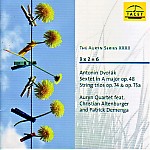This is a splendidly intelligent coupling: three fine works for unusual chamber forces. The second Terzetto, Op. 75a, is better known in its arrangement for violin and piano as the Romantic Pieces, but there’s an excellent argument in favor of Dvorák’s original conception. The very slightly earlier Terzetto Op. 74 (for the unusual combination of two violins and viola) is a very great work, with a magnificent final theme and variations that’s brilliantly played here. Violist Stewart Eaton has a major task: he has to sing but also put a bass on the entire ensemble, and he’s fully up to the task.
Great sextets are few and far between, even in the 19th century, and their relative scarcity explains their infrequency of performance. The presence of another of Dvorák’s delightful variation finales unifies the program, but there are many more riches to be found in this piece, including a second-movement Dumka and a scherzo that shares a theme with the first Slavonic Dance. Once again the performance is all that anyone could want: ripely romantic and lush, but also rhythmically incisive and full of color. The Dumka in particular has a wholly idiomatic, Slavic intensity. Toss in state-of-the-art sonics and you have a stunning release all around. [6/16/2011]
































